1993 CADILLAC FLEETWOOD towing
[x] Cancel search: towingPage 98 of 386
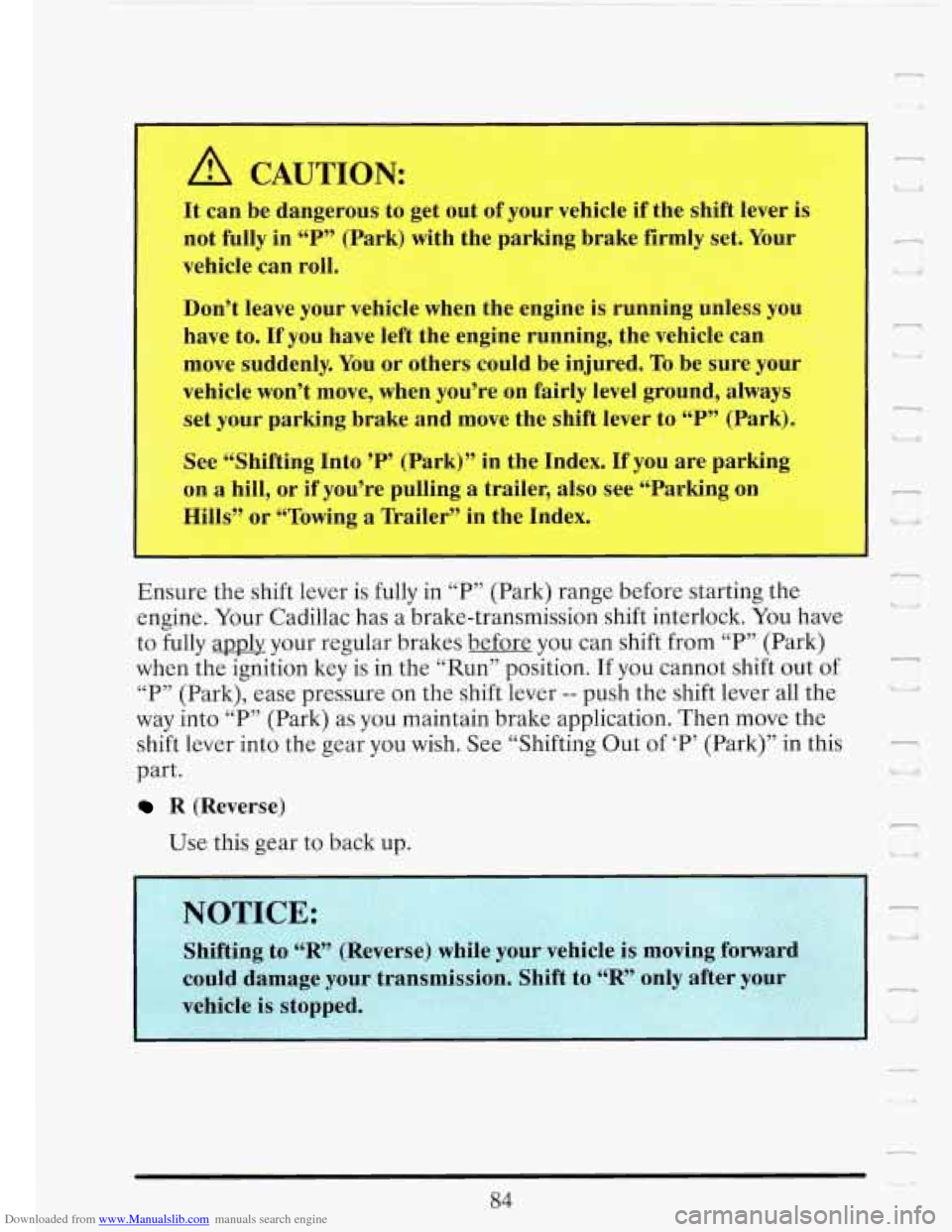
Downloaded from www.Manualslib.com manuals search engine A CAUTION:
It can be dangerous to get out of your vehicle if the shift lever is
not fully
in “P” (Park) with the parking brake firmly set. Your
vehicle can roll.
Don’t leave your vehicle when the engine is running unless
you
have to. If you have left the engine running, the vehicle can
move suddenly. You or others could be injured.
To be sure your
vehicle won’t move, when you’re on fairly level ground,
always
set your parking brake and move the shift lever to “P” (Park).
See “Shifting Into ’P’ (Park)” in the Index. If you are parking
on
a hill, or if you’re pulling a trailer, also see “Parking on
Hills’’ or “Towing a Railer” in the Index.
Ensure the shift lever is fully in “P” (Park) range before starting the
engine. Your Cadillac has a brake-transmission shift interlock. You have
to fully apply your regular brakes before you can shift
from “P” (Park)
when the ignition key
is in the “Run” position. If you cannot shift out of
“P” (Park), ease pressure on the shift lever
-- push the shift lever all the
way into “P” (Park) as you maintain brake application. Then move the
shift lever into the gear you wish. See “Shifting Out of
‘P’ (Park)” in this
part.
R (Reverse)
Use this gear to back up.
I
ha
1 UI
r
.i
I 4
84
‘- I
Page 100 of 386
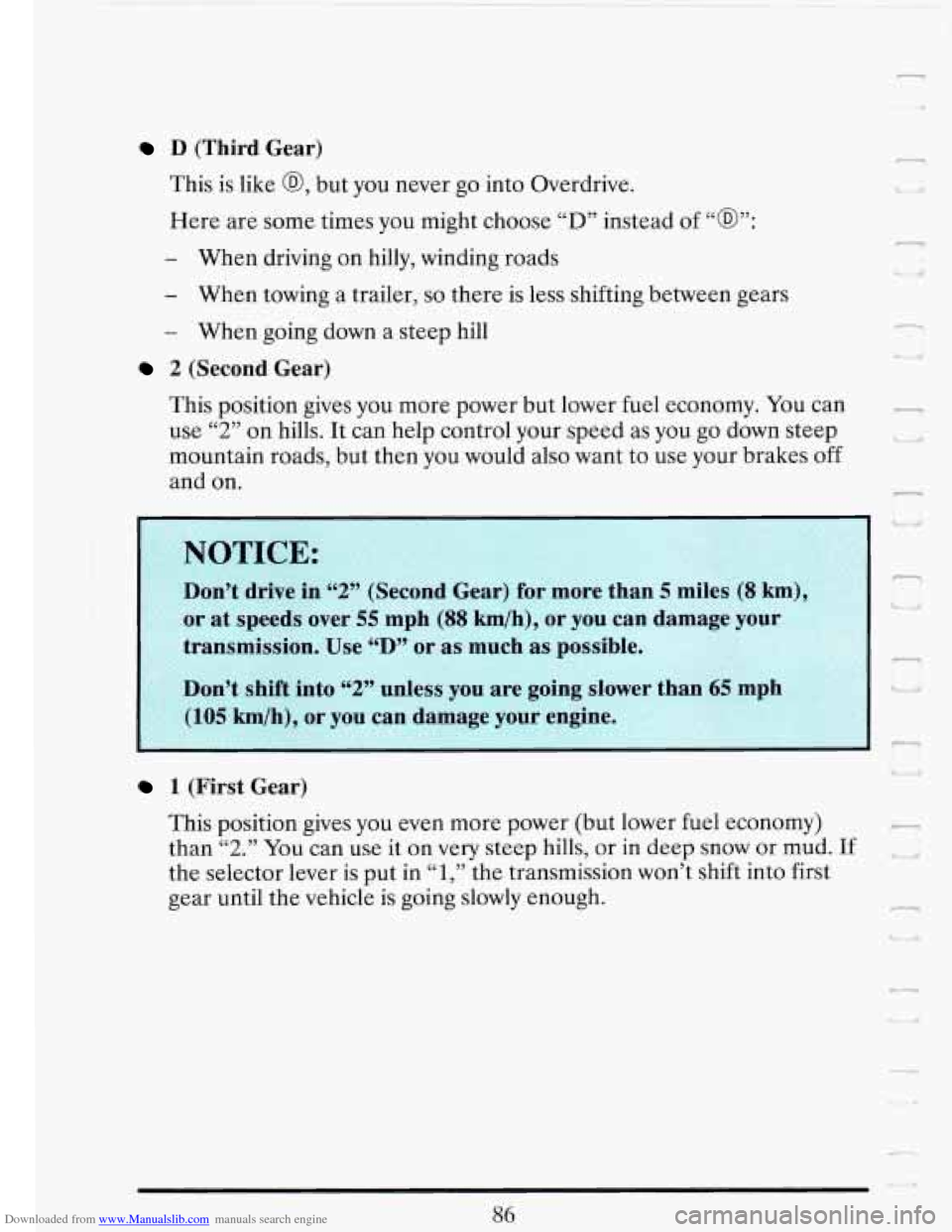
Downloaded from www.Manualslib.com manuals search engine D (Third Gear)
This is like
@, but you never go into Overdrive.
Here are some times you might choose
“D” instead of “a”:
- When driving on hilly, winding roads
- When towing a trailer, so there is less shifting between gears
- When going down a steep hill
2 (Second Gear)
P
bl ia
This position gives you more power but lower fuel economy. You can -
use 2 on hills. It can help control your speed as you go down steep
mountain roads, but then you would also want to use your brakes
off
and on.
cc 97 ,>
NOTICE:
Don’t drive in “2” (Second Gear) for more than 5 miles (8 km),
or at speeds over 55 mph (88 km/h), or you can damage your
transmission. Use “D” or as much
as possible.
Don’t shift into
“2” u are going slower than 65 mph
(105 km/h), or you can damage your engine.
1 (First Gear)
I-
This position gives you even more power (but lower fuel economy) r
than “2.” You can use it on very steep hills, or in deep snow or mud. If I
the selector lever is put in “1,” the transmission won’t shift into first
gear until the vehicle is going slowly enough.
- I,
U
-.
L.
86
Page 103 of 386
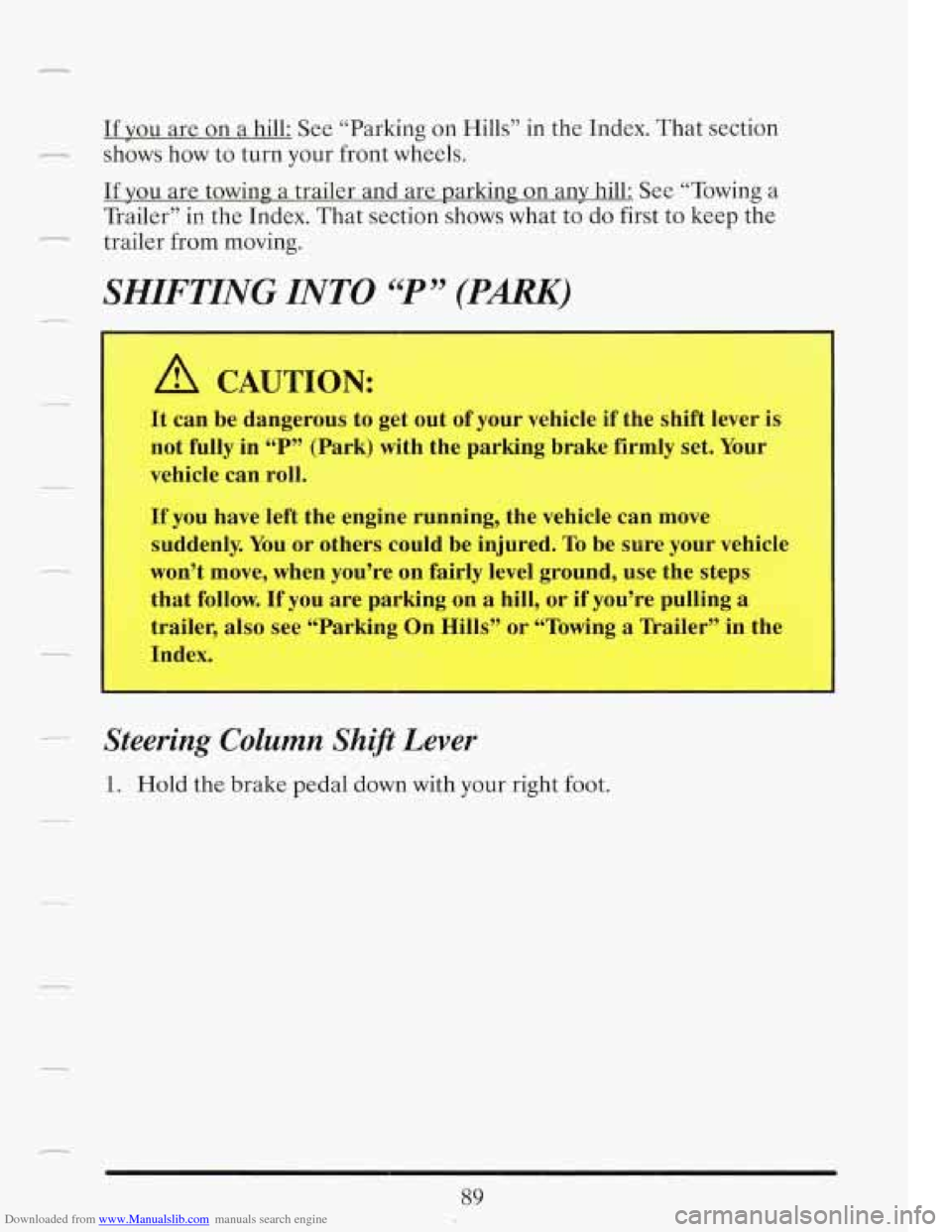
Downloaded from www.Manualslib.com manuals search engine If vou are on a hill: See “Parking on Hills” in the Index. That section
shows how to turn your front wheels.
If you are towing a trailer and are parking on any hill: See “Towing a
Trailer”
in the Index. That section shows what to do first to keep the
trailer from moving.
SHIFTING INTO “P” (PARK)
I A CAUTION:
It can be dangerous to get out of your vehicle if the shift lever is
not fully in
“P” (Park) with the parking brake firmly set. Your
vehicle can roll.
If you have left the engine running, the vehicle can move
suddenly. You or others could be injured. To be sure your vehicle
won’t move, when you’re on fairly level ground, use the steps
that follow.
If you are parking on a hill, or if you’re pulling a
trailer, also see “Parking On Hills” or “Towing a Trailer” in the
~ Index.
Steering Column Shift Lever
1. Hold the brake pedal down with your right foot.
89
Page 108 of 386
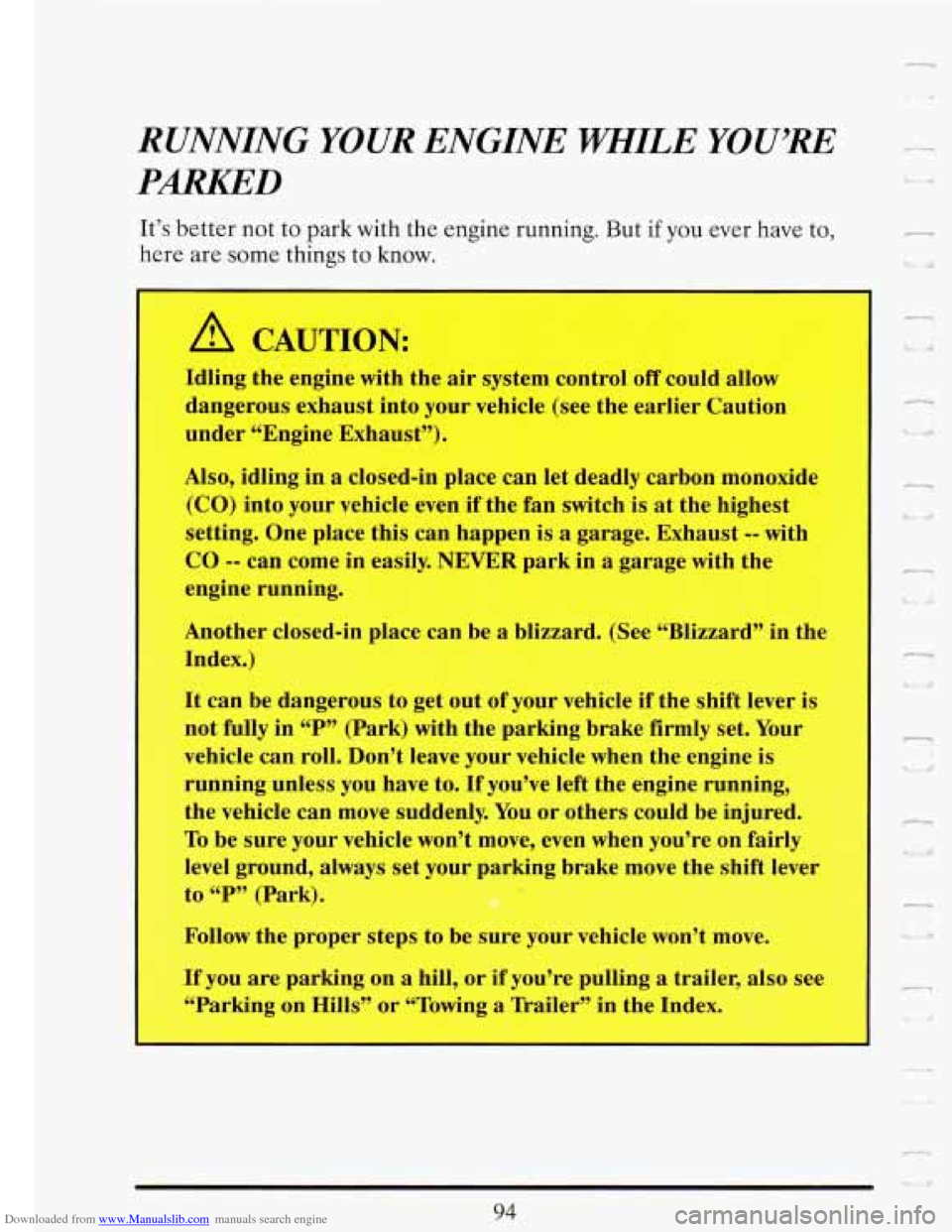
Downloaded from www.Manualslib.com manuals search engine RUNNING YOUR ENGINE WHILE YOU’RE
PARKED
It’s better not to park with the engine running. But if you ever have to,
here are some things to know.
A CAUTION:
Idling the engine with the air system control off could allow
dangerous exhaust
into your vehicle (see the earlier Caution
under “Engine Exhaust”).
Also, idling in a closed-in place can let deadly I- --moa monoxide
(CO) into your vehicle even if the fan switch is at the highest
setting. One place this
can happen is a garage. Exhaust -- with
CO -- can came in easily. NEWER park in. a garage with the
engine running.
Another
closed-in place can be a blizzard. (See “Blizzard” in the
Index,)
It can be dangerous to get out of your vehicle if the shift lever is
not fnhly in “P” (Park) with the parking brake firmly set. Your
vehicle can dI. l3on’t leave your vehicle when the engine is
running unless you have to. If you’ve left the engine running,
the vehicle can move suddenly. You or others could be injured.
Ta be $we your vehicle won’t move, even when you’re on fairly
level
ground, always set your parking brake move the shift lever
to “P” (Park). i
Follow the proper steps to be sure your vehicle won’t move,
If you ,am parking on zt hill, OT if you’re pulling a trailer, also see
“Parking on Hills” or “Towing a Ikrriler” in the Index.
94
- ’i LY
Page 113 of 386
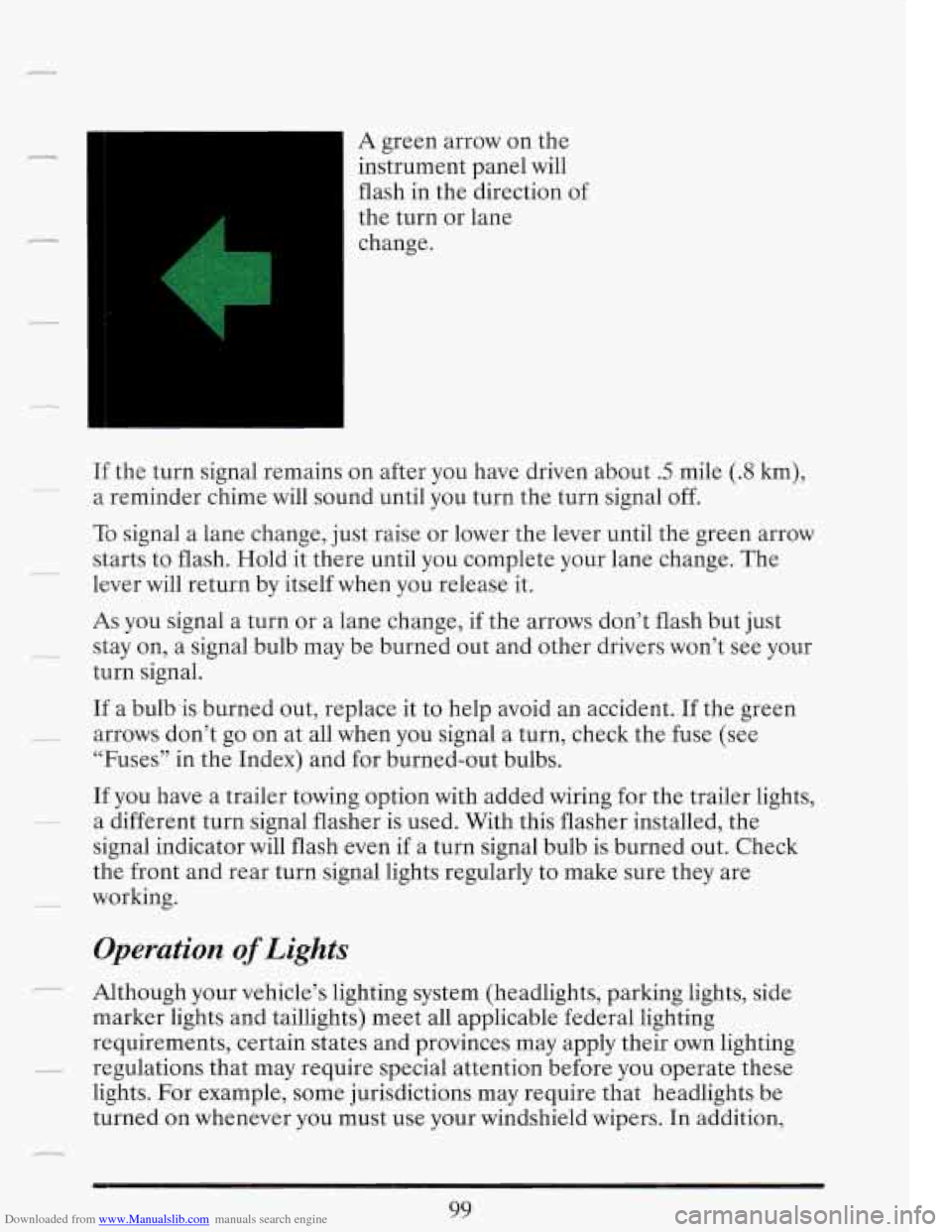
Downloaded from www.Manualslib.com manuals search engine A green arrow on the
instrument panel will
flash in the direction of
the turn or lane
change.
If the turn signal remains on after you have driven about .5 mile (.8 km),
a reminder chime will sound until you turn the turn signal off.
To signal a lane change, just raise or lower the lever until the green arrow
starts to flash. Hold it there until you complete your lane change. The
lever will return by itself when you release it.
AS you signal a turn or a lane change, if the arrows don’t flash but just
stay on, a signal bulb may be burned out and other drivers won’t see your
turn signal.
If a bulb is burned out, replace it to help avoid an accident. If the green
arrows don’t go on at all when you signal a turn, check the fuse (see
“Fuses” in the Index) and for burned-out bulbs.
If you have a trailer towing option with added wiring for the trailer lights,
a different turn signal flasher is used. With this flasher installed, the
signal indicator will flash even if a turn signal bulb is burned out. Check
the front and rear turn signal lights regularly to make sure they are
working.
Operation of Lights
Although your vehicle’s lighting system (headlights, parking lights, side
marker lights and taillights) meet all applicable federal lighting
requirements, certain states and provinces may apply their own lighting
regulations that may require special attention before you operate these
lights. For example, some jurisdictions may require that headlights be
turned on whenever you must use your windshield wipers. In addition,
Page 132 of 386
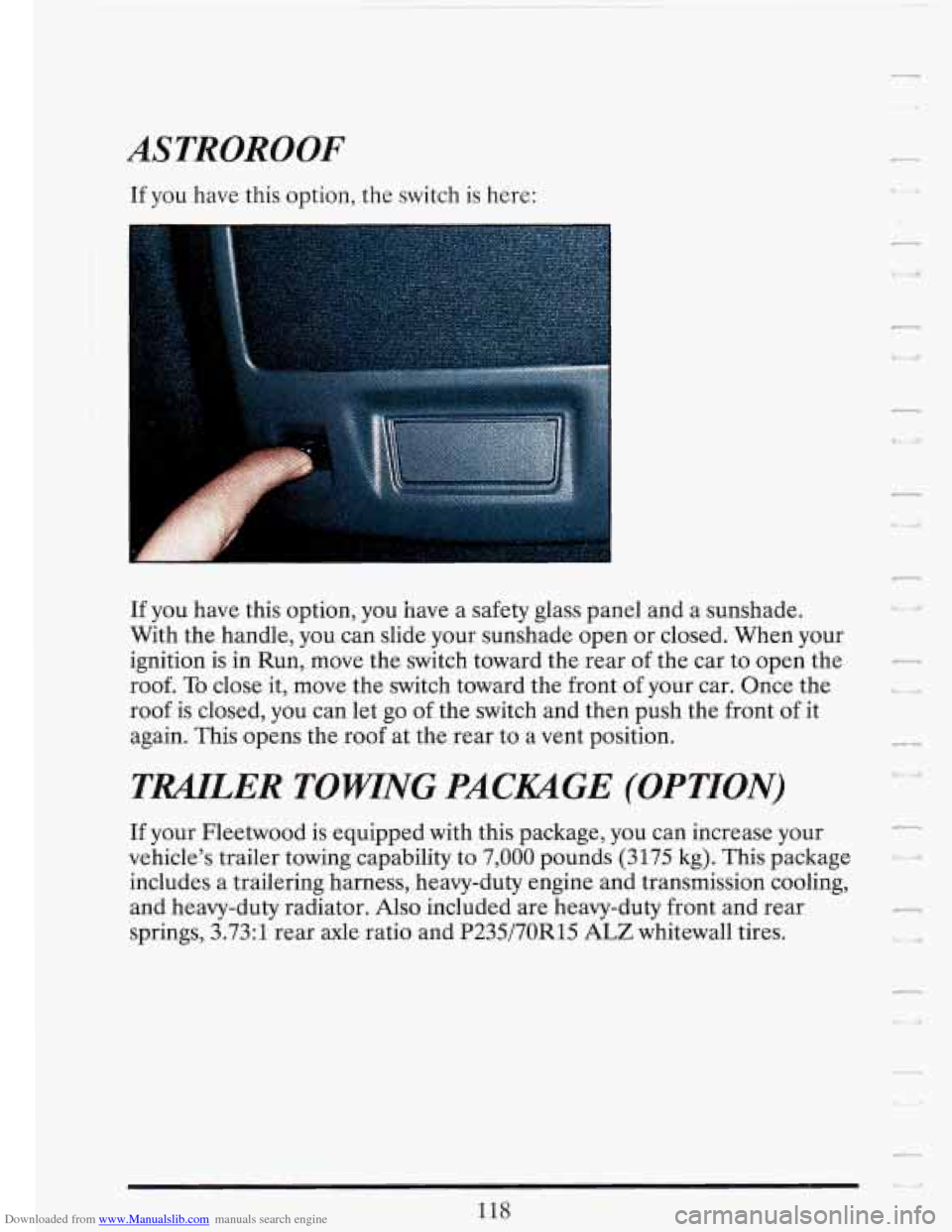
Downloaded from www.Manualslib.com manuals search engine ASTROROOF
If you have this option, the switch is here:
_.
If you have this option, you have a safety glass panel and a sunshade.
With the handle, you can slide your sunshade open or closed. When your
ignition is
in Run, move the switch toward the rear of the car to open the
roof.
To close it, move the switch toward the front of your car. Once the
roof is closed, you can let
go of the switch and then push the front of it
again. This opens the roof at the rear to a vent position.
TWLER TOWING PACKAGE (OPTION)
If your Fleetwood is equipped with this package, you can increase your 7
vehicle's trailer towing capability to 7,000 pounds (3175 kg). This package '
includes a trailering harness, heavy-duty engine and transmission cooling,
and heavy-duty radiator.
Also included are heavy-duty front and rear
springs, 3.73:l rear axle ratio and P235/70R15
ALZ whitewall tires.
7
n
Page 140 of 386
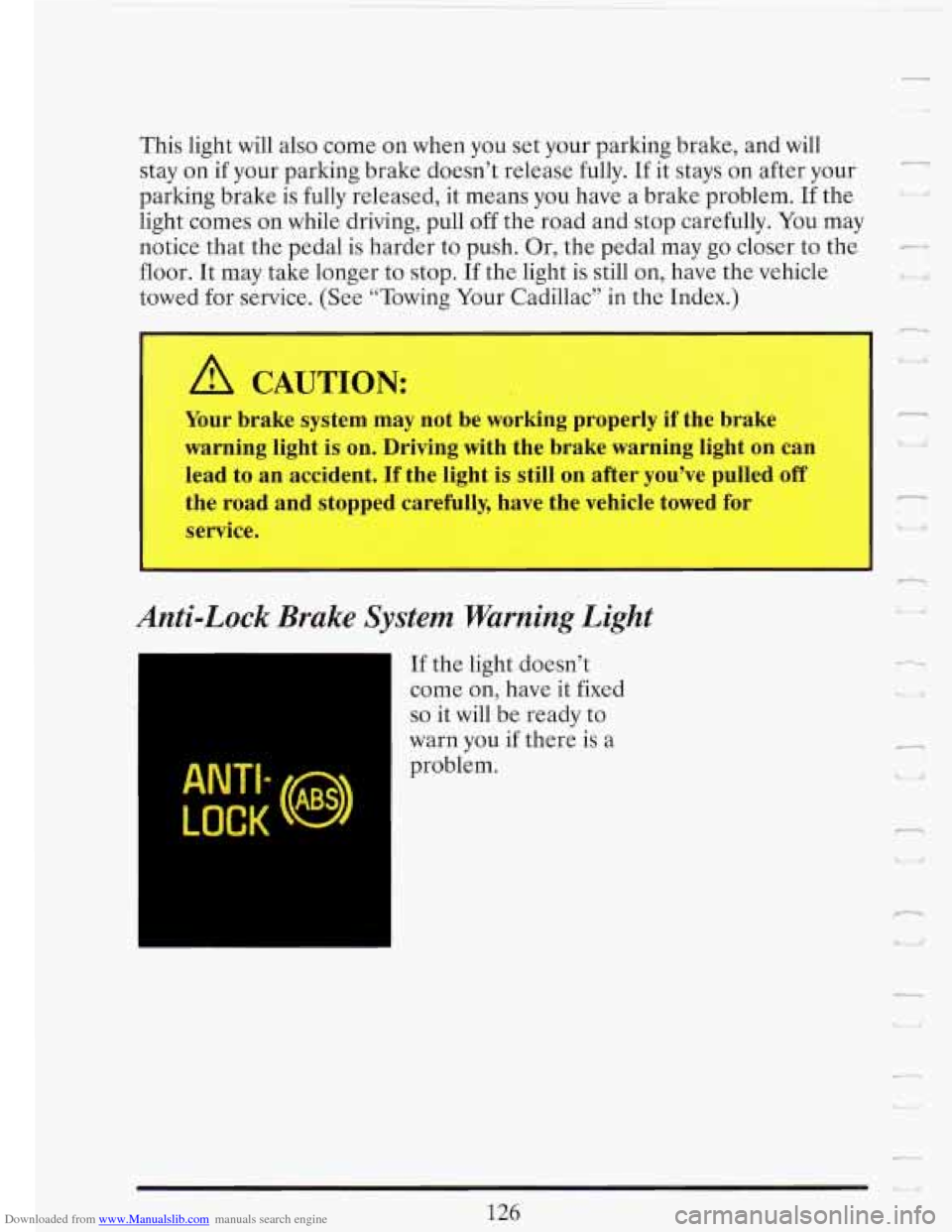
Downloaded from www.Manualslib.com manuals search engine -I
This light will also come on when you set your parking brake, and will
stay on if your parking brake doesn’t release fully. If it stays
on after your
parking brake is fully released, it means you have a brake problem.
If the
light comes on while driving, pull off the road and stop carefully.
You may
notice that the pedal
is harder to push. Or, the pedal may go closer to the
floor. It may take longer to stop. If the light is still
on, have the vehicle
towed for service. (See “Towing Your Cadillac” in the Index.)
A CAUTION:
Your brake system may not be working properly if the brake
warning light
is on. Driving with the brake warning light on can
lead to an accident.
If the light is still on after you’ve pulled off
the road and stopped carefully, have the vehicle towed for
service.
~
Anti-Lock Brake System Warning Light
ANTI
(
If the light doesn’t
come on, have
it fixed
so it will be ready to
warn you if there is a
problem.
126
,_.
h&
I n
w
4 .,
Page 222 of 386
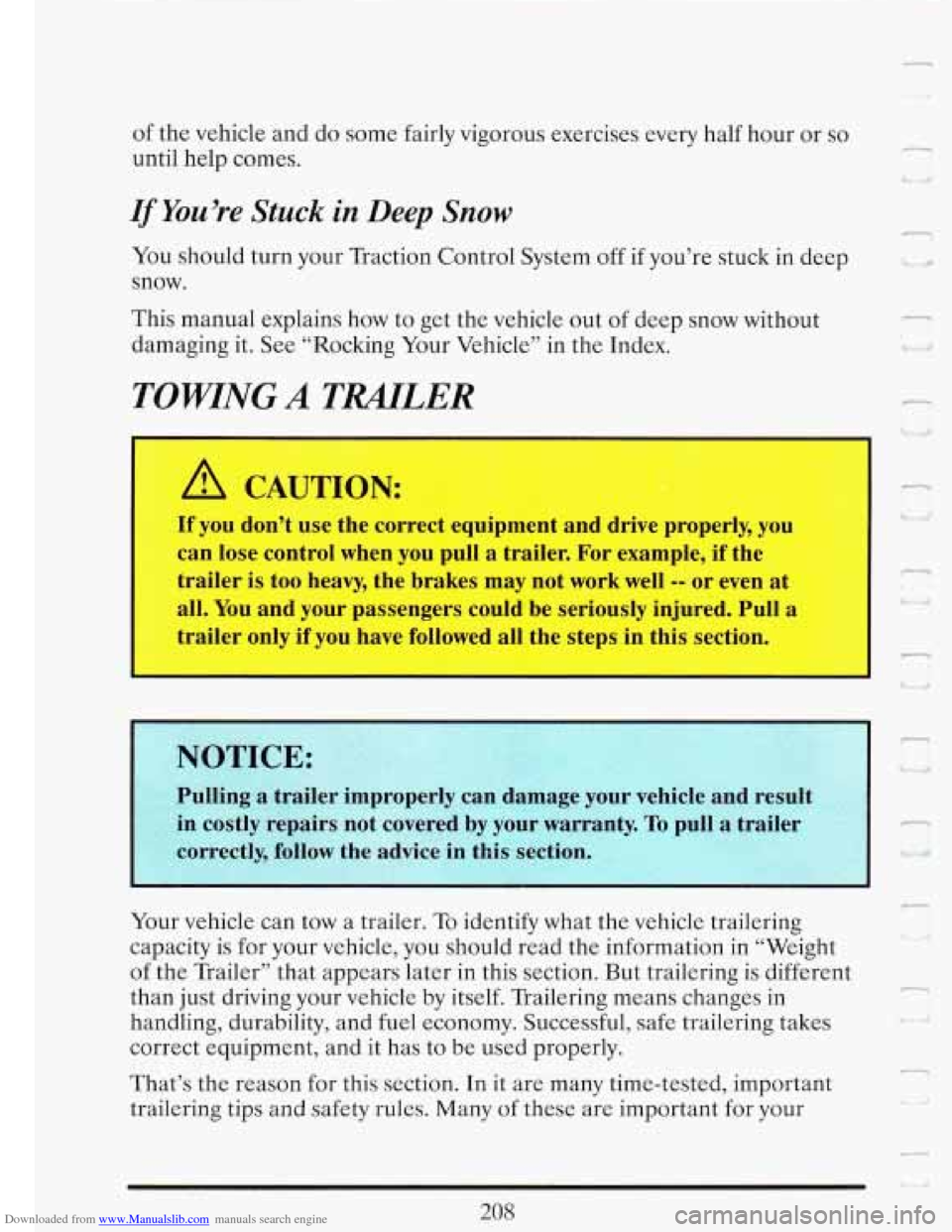
Downloaded from www.Manualslib.com manuals search engine of the vehicle and do some fairly vigorous exercises every half hour or so
until help comes.
If You’re Stuck in Deep Snow
You should turn your Traction Control System off if you’re stuck in deep
snow.
This manual explains how
to get the vehicle out of deep snow without
damaging it. See “Rocking Your Vehicle” in the Index.
TOWING A TMLER
A CAUTION:
If you don’t use the correct equipment and drive properly, you
can lose control when you pull a trailer. For example, if the
trailer is too heavy, the brakes may not work well
-- or even at
all.
You and your passengers could be seriously injured. Pull a
trailer only if you have followed all the steps in this section.
I
~~ ~ ~~ id
7
\. i
Pulling a trailer improperly can damage your vehicle and result
in costly repairs not covered by your warranty.
To pull a trailer -
c*
Your vehicle can tow a trailer. To identify what the vehicle trailering ;
capacity is for your vehicle, you should read the information in “Weight
of the Trailer” that appears later in this section. But trailering is different
than just driving your vehicle by itself. Trailering means changes in
handling, durability, and fuel economy. Successful, safe trailering takes
correct equipment, and it has to be used properly.
-
That’s the reason for this section. In it are many time-tested, important
trailering tips and safety rules. Many of these are important for your m .> d
c-
.J ~
208